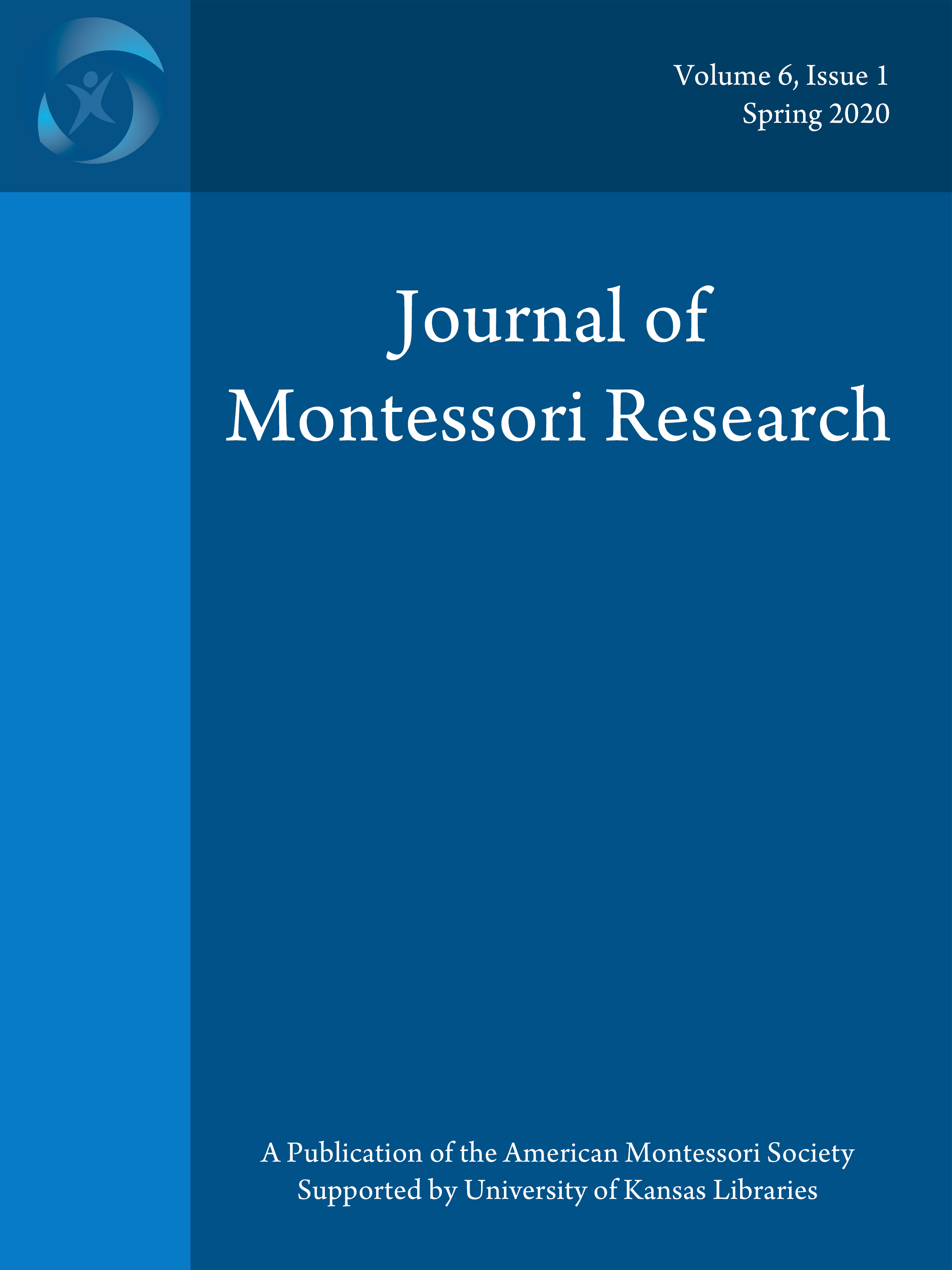Teaching in the Montessori Classroom
Investigating Variation Theory and Embodiment as a Foundation of Teachers’ Development
DOI:
https://doi.org/10.17161/jomr.v6i1.12051Keywords:
Montessori, embodiment, geometry material, mathematics, teachers' development, variation theoryAbstract
The theory of Montessori education has been interpreted by some researchers to be vaguely formulated. However, as shown in previous research, Maria Montessori’s didactic approach to teaching and learning mathematics is fully consistent with variation theory and the theory of embodiment. Dr. Montessori used the theoretical concept of isolation of quality, which means that the learning objects have to be kept identical except for one variable, which has to differ to be perceptible. This concept is in alignment with variation theory, which emphasizes variation as a necessary condition for learners to discern aspects of an object of learning. The other theory applied in this article is the theory of embodiment: important cognitive functions are fundamentally grounded in action that is concordant with Dr. Montessori’s view that mind and movement are parts of the same entity.
This article reports on a qualitative single-case study with a formative intention in which we investigated the significance of being acquainted with variation theory and the theory of embodiment when working with Montessori material. The study analyzes a teacher’s mathematics presentations with the Montessori material and the children’s work with this material, using Epistemological Move Analysis, which focuses on how the teacher directs children’s learning. The analysis was shared with the teacher to support her awareness of the ways teaching can be developed from a variation and embodiment theoretical perspective. Results show that the teacher’s awareness of why a specific learning object be treated in accordance with variation theory and embodiment seems to promote a more constructive and effective way to direct children’s learning.
References
Ahlquist, E.-M. T., & Gynther, P. (2019). Variation theory and Montessori education. Journal of Montessori Research & Education, 2(1), 13–23. http://doi.org/10.16993/jmre.12
Battista, M. T. (2007). The development of geometric and spatial thinking. In F. K. Lester (Ed.), Second handbook of research on mathematics teaching and learning (pp. 843–908). Information Age.
Blatchford, P. (2003). A systematic observational study of teachers’ and pupils’ behavior in large and small classes. Learning and Instruction, 13(6), 569–595. https://doi.org/10.1016/S0959-4752(02)00043-9
Cossentino, J. (2009). Culture, craft, & coherence: The unexpected vitality of Montessori teacher training. Journal of Teacher Education, 60(5), 520–527. https://doi.org/10.1177/0022487109344593
Feez, S. (2007). Montessori’s mediation of meaning: A social semiotic perspective [Doctoral dissertation, University of Sydney]. Sydney Digital Theses (Open Access). http://hdl.handle.net/2123/1859
Johnson, M. (2007). The meaning of the body: Aesthetics of human understanding. University of Chicago Press.
Lakoff, G., & Johnson, M. (1999). Philosophy in the flesh: The embodied mind and its challenge to Western thought. Basic Books.
Lidar, M., Lundqvist, E., & Östman, L. (2006). Teaching and learning in the science classroom: The interplay between teachers’ epistemological moves and students’ practical epistemology. Science Education, 90(1), 148–163. https://doi.org/10.1002/sce.20092
Littler, G., & Jirotková, D. (2004). Learning about solids. In B. Clarke & National Center for Mathematics Education (Eds.), International perspectives on learning and teaching mathematics (pp. 51–66). Göteborg University, National Center for Mathematics Education.
Lillard, A. S. (2005). Montessori: The science behind the genius. Oxford University Press.
Lithner, J. (2015). Learning mathematics by imitative or creative reasoning. In S. J. Cho (Ed.), Selected regular lectures from the 12th International Congress on Mathematical Education (pp. 487–506). Springer International Publishing.
Lo, M. L. (2012). Variation theory and the improvement of teaching and learning. Acta Universitatis Gothoburgensis.
Lundqvist, E., Almqvist, J., & Östman, L. (2012). Institutional traditions in teachers’ manners of teaching. Cultural Studies of Science Education, 7(1), 111–127. https://doi.org/10.1007/s11422-011-9375-x
Marton, F. (2006). Sameness and difference in transfer. Journal of the Learning Sciences, 15(4), 501–539. https://doi.org/10.1207/s15327809jls1504_3
Marton, F. (2015). Necessary conditions of learning. Routledge.
Marton, F., & Booth, S. (1997). Learning and awareness. Lawrence Erlbaum Associates.
Marton, F., & Signert, K. (2008). Sinnenas skolning—variation och invarians i Maria Montessoris pedagogik [Educating the senses—variation and invariance in Maria Montessori’s pedagogy]. In H. Rystedt & R. Säljö (Eds.), Kunskap och människans redskap: Teknik och lärande [Knowledge and human tools: Technology and learning] (pp. 179–194). Studentlitteratur AB.
Merleau-Ponty, M. (2004). Phenomenology of perception. Routledge.
Montessori, M. (1964). The Montessori Method. Schocken. (Original work published 1912)
Montessori, M. (1965). Dr. Montessori’s own handbook. Schocken. (Original work published 1914)
Montessori, M. (1972). The discovery of the child. Ballantine. (Original work published 1948)
Montessori, M. (1982). The absorbent mind. Kalakshetra. (Original work published 1949)
Montessori, M. (1996). From childhood to adolescence. Montessori-Pierson. (Original work published 1948)
Montessori, M. (2011). Psychogeometry. Montessori-Pierson.
Montessori, M. M., Jr. (1992). Education for human development: Understanding Montessori (ED136940). ERIC. https://files.eric.ed.gov/fulltext/ED136940.pdf
Mwingirwa, M. I., Marguerite, M. K., & Khatete, D. (2015). Teachers’ perspectives towards use of technology, the case of GeoGebra in teaching mathematics in Kenya. Scientific Research Journal (SCIRJ), III, (IX), 19–24.
Signert, K. (2012). Variation och invarians i Maria Montessoris sinnestränande materiel. [Variation and invariance in Maria Montessori’s sensory training materials] [Doctoral dissertation, University of Gothenburg, Sweden]. https://gupea.ub.gu.se/bitstream/2077/30158/2/gupea_2077_30158_2.pdf
Wiliam, D. (2019). Att följa lärande: Formativ bedömning i praktiken [Embedded formative assessment] (2nd ed.). Studentlitteratur AB.
Yin, R. K. (1994). Case study research: Design and methods (2nd ed.) SAGE Publications.


